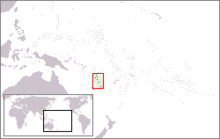The following outline is provided as an overview of and topical guide to Vanuatu:


Vanuatu – sovereign island nation located in the South Pacific Ocean.[1] The Vanuatu Archipelago is some 1,750 kilometres (1,087 mi) east of northern Australia, 500 km (310 mi) north-east of New Caledonia, west of Fiji, and south of the Solomon Islands. The archipelago is of volcanic origin. Vanuatu was first inhabited by Melanesian people. Europeans began to settle in the area in the late 18th century. In the 1880s France and the United Kingdom claimed parts of the country and in 1906 they agreed on a framework for jointly managing the archipelago through a British-French Condominium as the New Hebrides. An independence movement was established in the 1970s, and the Republic of Vanuatu was created in 1980.
General reference
edit- Pronunciation:
- Common English country name: Vanuatu
- Official English country name: The Republic of Vanuatu
- Common endonym(s):
- Official endonym(s):
- Adjectival(s): Ni-Vanuatu, Vanuatuan
- Demonym(s):
- Etymology: Name of Vanuatu
- ISO country codes: VU, VUT, 548
- ISO region codes: See ISO 3166-2:VU
- Internet country code top-level domain: .vu
Geography of Vanuatu
edit- Vanuatu is: a country
- Location:
- Southern Hemisphere and Eastern Hemisphere
- Oceania
- Time zone: UTC+11
- Extreme points of Vanuatu
- High: Mount Tabwemasana on Espiritu Santo 1,877 m (6,158 ft)
- Low: South Pacific Ocean 0 m
- Land boundaries: none
- Coastline: South Pacific Ocean 2,528 km (1,571 mi)
- Population of Vanuatu: 301,000 - 173rd most populous country
- Area of Vanuatu: 12,189 km2 (4,706 sq mi)
- Atlas of Vanuatu
Environment of Vanuatu
edit- Climate of Vanuatu
- Renewable energy in Vanuatu
- Geology of Vanuatu
- Protected areas of Vanuatu
- Wildlife of Vanuatu
Natural geographic features of Vanuatu
edit- Islands of Vanuatu
- Lakes of Vanuatu
- Mountains of Vanuatu
- Rivers of Vanuatu
- Valleys of Vanuatu
- World Heritage Sites in Vanuatu: Chief Roi Mata’s Domain
Regions of Vanuatu
editEcoregions of Vanuatu
editAdministrative divisions of Vanuatu
editAdministrative divisions of Vanuatu
Provinces of Vanuatu
editDemography of Vanuatu
editGovernment and politics of Vanuatu
edit- Form of government: parliamentary representative democratic republic
- Capital of Vanuatu: Port Vila
- Elections in Vanuatu
- Political parties in Vanuatu
Branches of the government of Vanuatu
editExecutive branch of the government of Vanuatu
edit- Head of state: President of Vanuatu, Nikenike Vurobaravu
- Head of government: Prime Minister of Vanuatu, Moana Carcasses Kalosil
- Cabinet: Council of Ministers of Vanuatu
- Malvatu Mauri (National Council of Chiefs) - role is advisory only
Legislative branch of the government of Vanuatu
editJudicial branch of the government of Vanuatu
editForeign relations of Vanuatu
editInternational organization membership
editThe Republic of Vanuatu is a member of:[1]
Law and order in Vanuatu
editMilitary of Vanuatu
editMilitary of Vanuatu Vanuatu has no military per se. The Vanuatu Mobile Force is a paramilitary force within the police force.[2]
Local government in Vanuatu
editHistory of Vanuatu
editCulture of Vanuatu
edit- Architecture of Vanuatu
- Cuisine of Vanuatu
- Festivals in Vanuatu
- Languages of Vanuatu
- Media in Vanuatu
- National symbols of Vanuatu
- People of Vanuatu
- Public holidays in Vanuatu
- Records of Vanuatu
- Religion in Vanuatu
- World Heritage Sites in Vanuatu
Art in Vanuatu
edit- Art in Vanuatu
- Cinema of Vanuatu
- Literature of Vanuatu
- Music of Vanuatu
- Television in Vanuatu
- Theatre in Vanuatu
Sports in Vanuatu
editEconomy and infrastructure of Vanuatu
editEducation in Vanuatu
editInfrastructure of Vanuatu
editSee also
editReferences
edit- ^ a b "Vanuatu". The World Factbook. United States Central Intelligence Agency. July 2, 2009. Retrieved July 23, 2009.
- ^ Miranda Forsyth, A bird that flies with two wings : the kastom and state justice systems in Vanuatu Archived 2012-04-19 at the Wayback Machine, Australian National University Press

